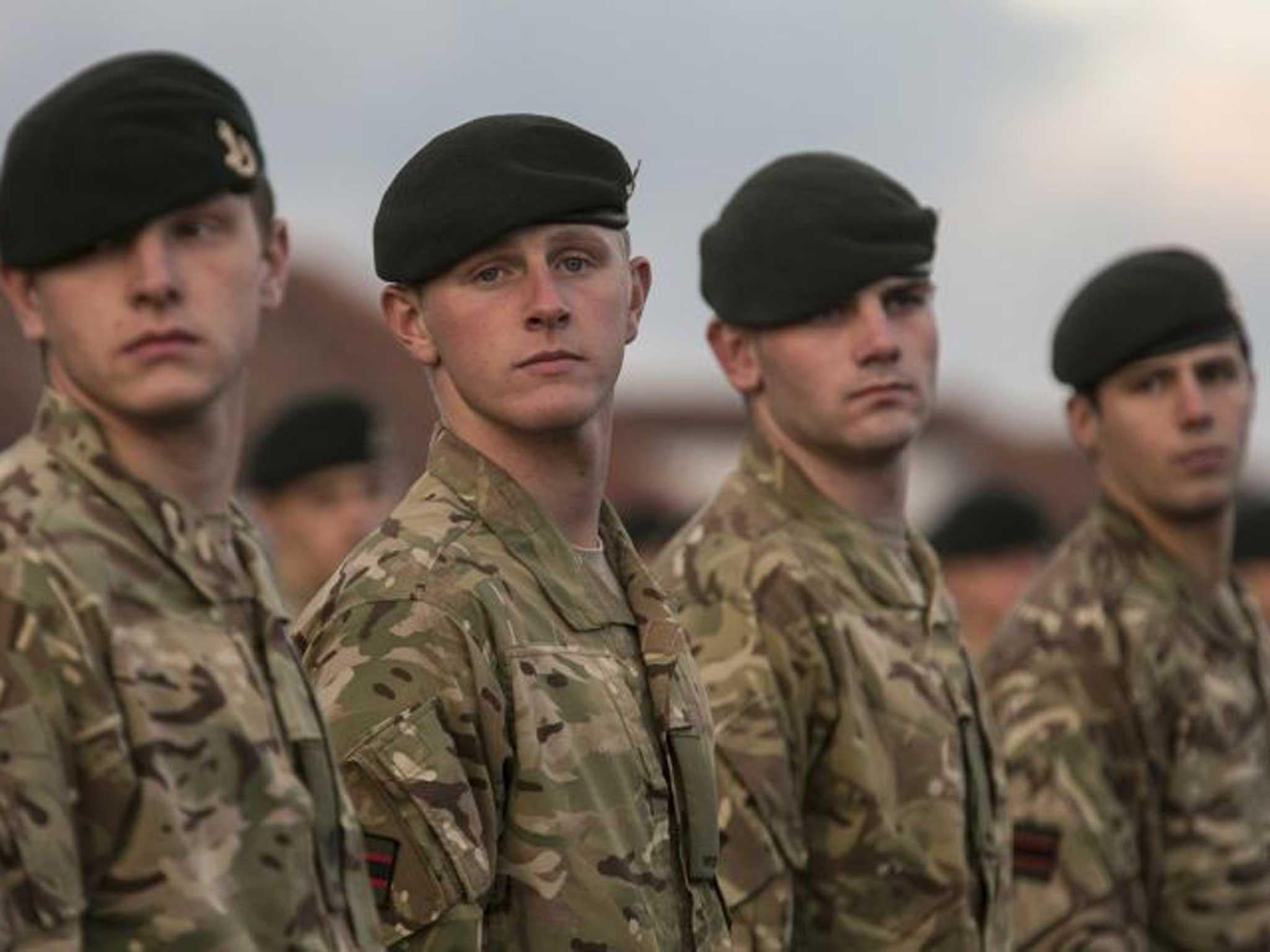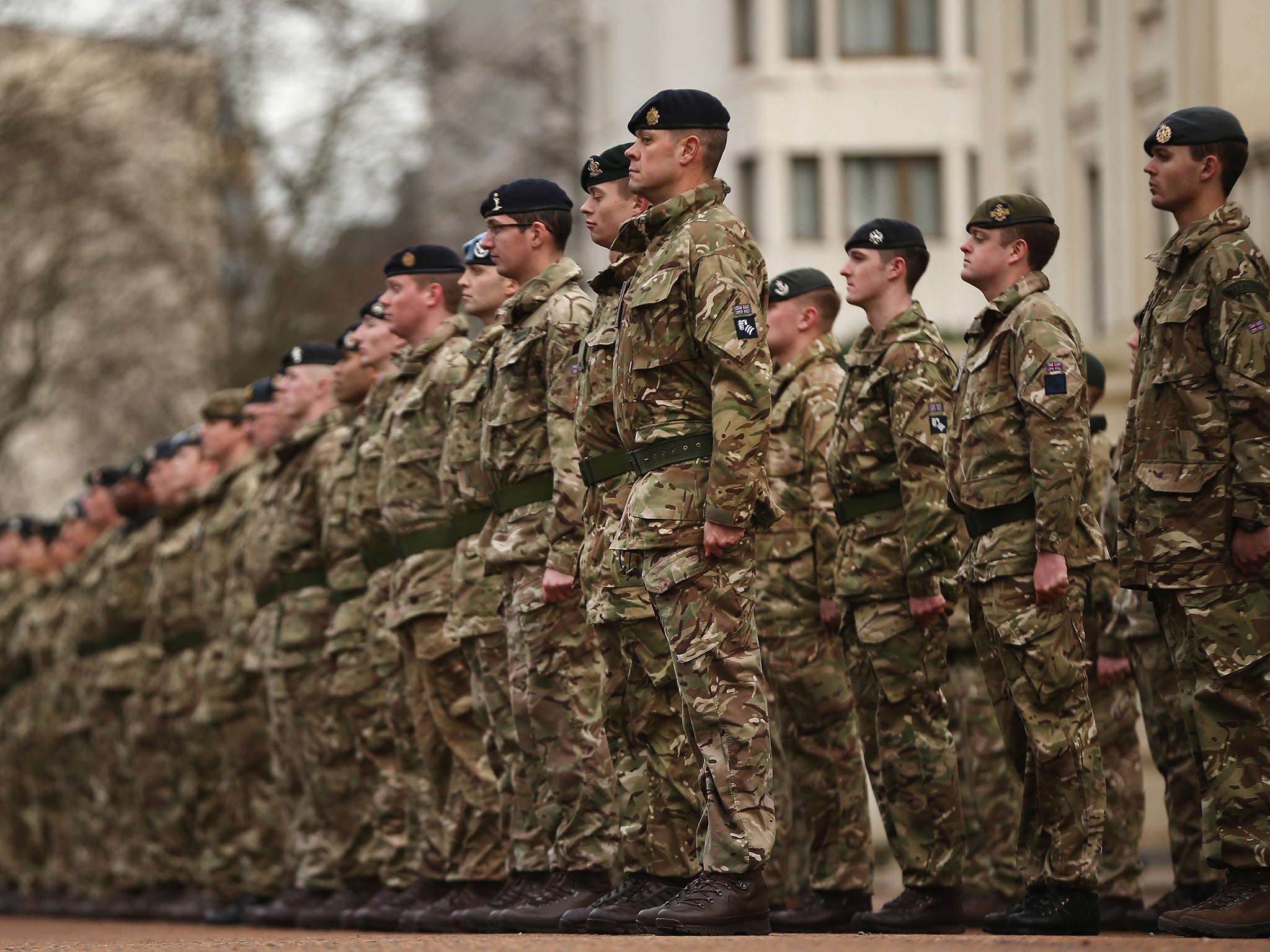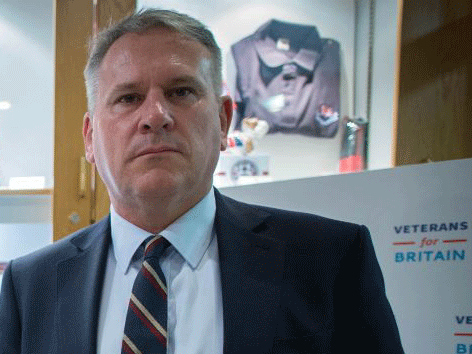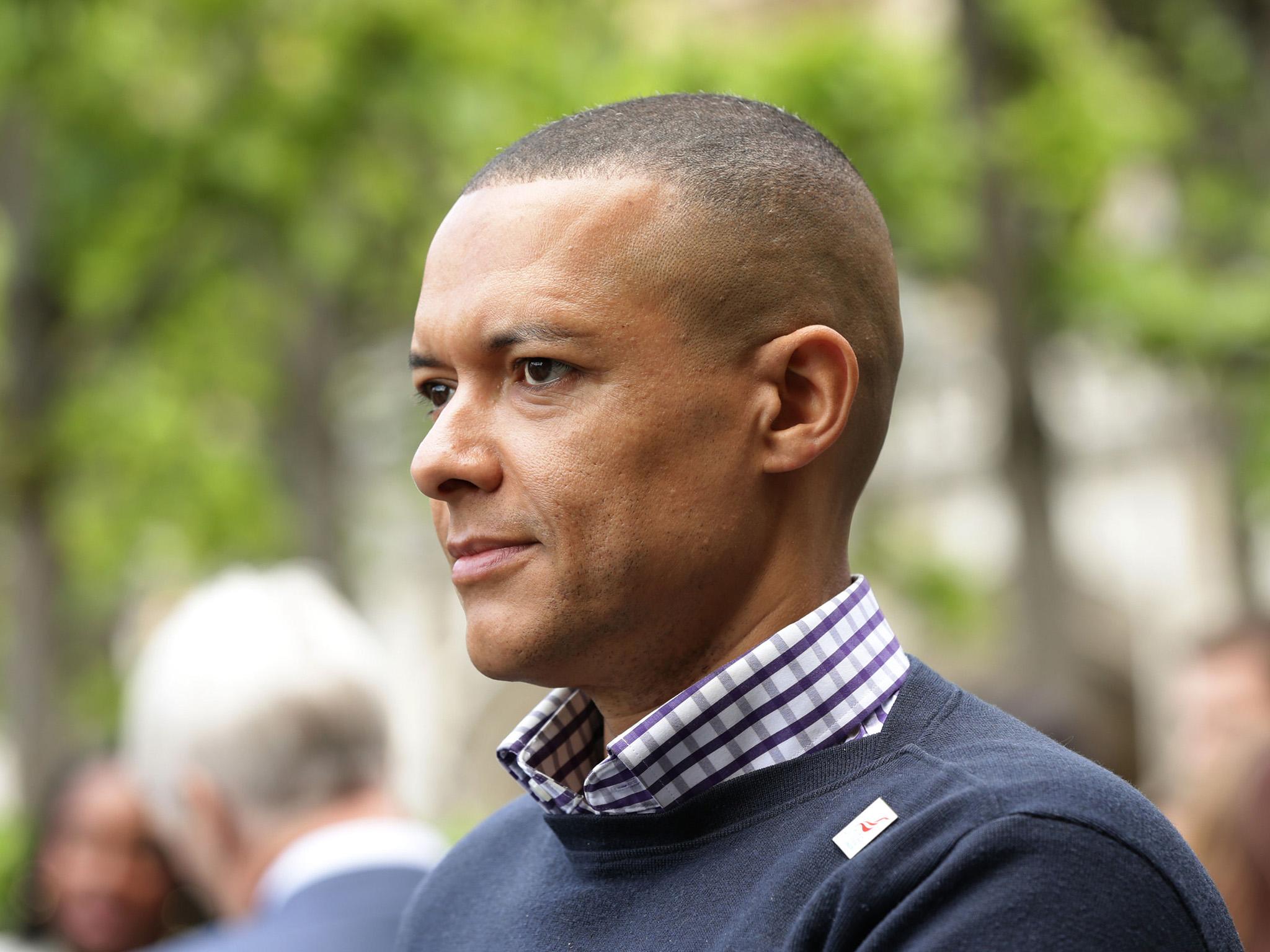Revealed: How the Government’s big austerity plan to replace regular soldiers with reservists has 'led to crisis'
Exclusive: Government figures published on the day Parliament closed for the summer prompt claims the Army faces a ‘crisis in recruitment and retention’, with a shortfall of 3,990 fully trained regular troops and an alarming drop in intake into the part-time Army Reserve

Your support helps us to tell the story
From reproductive rights to climate change to Big Tech, The Independent is on the ground when the story is developing. Whether it's investigating the financials of Elon Musk's pro-Trump PAC or producing our latest documentary, 'The A Word', which shines a light on the American women fighting for reproductive rights, we know how important it is to parse out the facts from the messaging.
At such a critical moment in US history, we need reporters on the ground. Your donation allows us to keep sending journalists to speak to both sides of the story.
The Independent is trusted by Americans across the entire political spectrum. And unlike many other quality news outlets, we choose not to lock Americans out of our reporting and analysis with paywalls. We believe quality journalism should be available to everyone, paid for by those who can afford it.
Your support makes all the difference.The Army is facing a “potentially very, very dangerous” crisis in trained soldier numbers because of a “flawed austerity drive” introduced by Chancellor Philip Hammond, according to claims prompted by figures released on the day Parliament closed for the summer.
The figures were among a raft of potentially embarrassing statistics released by the Conservative Government on Thursday, hours before Parliament broke up for the summer, in what critics interpreted as a deliberate “take out the trash day” tactic to limit the time MPs could spend discussing them.
The Armed Forces Service Personnel Statistics show that the numbers of fully trained regular Army soldiers has dropped below a previous ”trained strength” target of 82,000 to 78,010 – a shortfall of 3,990 fully trained troops.
Perhaps more importantly for the Government’s overall defence plans, the figures also show that the numbers leaving the part-time Army Reserve – formerly the Territorial Army – increased by 20 per cent between the year to 1 June 2016 and the year to 1 June 2017.
At about the same time, during the last financial year, intake into the reserve fell by 18 per cent.
Both figures raise doubts about whether the number of part-time soldiers can rise by more than 3,000 in three years to produce an Army Reserve of more than 30,000 by 2020 – a target that has been key to armed forces planning since 2012 when Philip Hammond, then the Defence Secretary, unveiled a plan to cut 20,000 soldiers from the regular Army by 2020.
Some critics have also claimed official figures now underplay the true scale of the problem because the Government has redefined ”trained soldiers” in a way that allows many more reservists to be counted in the part-time force’s “trained strength”.

When Mr Hammond introduced the initial plan in 2012, he insisted that cutting the full-time Army to its smallest size since the 19th century would be possible because this would be offset by increasing the strength of the Army Reserve from 19,000 to 30,000 part-time soldiers by 2020.
He also justified reducing regular soldier numbers from 102,000 to 82,000 by relating it to the need for austerity and citing the “massive overspend” inherited from the previous Labour Government.
But from the beginning, the plan was dogged by claims that the target of increasing reservist numbers by 58 per cent was unrealistic.
In June 2015, the independent Major Projects Authority gave the Army Reserve plan a red rating, reserved for schemes that appear unachievable.
The Government pressed on with the Army 2020 plan, insisting it had taken “significant steps” to address issues raised by the red rating.
Now, however, the new figures have led to stinging criticism of the Army 2020 plan unveiled by Mr Hammond, with the former commander of British forces in Afghanistan telling The Independent he feared that while reserve numbers are increasing, they are not rising fast enough to meet the crucial target of more than 30,000 reservists by 2020.
Colonel Richard Kemp, who took command of British forces in Afghanistan in 2003, said he was “extremely worried” by the latest figures.
He said: “From the beginning, many people had the view that the target for TA [Army Reserve] figures would not be reached, and I think it’s now unlikely it will be.
“The Army 2020 plan is not working and it’s not going to work.”
Insisting that the blame lay with politicians who insisted on armed forces budget cuts, he said: “I would point the finger at the politicians who have put the Army in this situation: the Prime Minister, the previous prime minister, the current Defence Secretary [Sir Michael Fallon] and his predecessor [Mr Hammond]. The generals have done the best they could have done with the huge budget cuts the Army has been faced with.

“Our soldiers are very, very high calibre people, but they – and the country – are being badly betrayed by the politicians who prioritised spending in places other than defence.
“It is a very dangerous economy to make. The current size of the armed forces is the most worrying I have ever known it to be.”
Drawing comparisons with the disarmament and appeasement policies of the 1930s, Colonel Kemp said: “We are facing an increasing threat, while reducing our capacity to deal with it.
“It doesn’t take a genius to see that we, as a country, are in a very dangerous situation now. The level of instability around the world is increasing daily. We are seeing North Korea flexing its muscles, the rise of Jihadism, questions over Russia’s intentions, and massive security challenges at home, which the Army will need to get involved in at some point.
“We are denying ourselves the ability to protect ourselves from all of this, or to deter those who pose very serious potential threats to us.
“We will pay for this in the end, as we did in the 1930s.”
Colonel Kemp was also highly critical of the Government’s reliance on the controversial outsourcing company Capita, which, in 2012, took over regular and reservist Army recruitment in a partnership contract said by the firm to be valued at around £44m a year for 10 years.
He said: “It was all done to save money, but privatising and civilianising Army recruitment is very much the wrong thing to do.
“There are far fewer occasions when potential recruits can have vital face-to-face contacts with soldiers. I have also personally been involved in trying to assist people into the Army who have found it almost impossible to overcome the bureaucracy.
“There are so many horror stories of people who want to join and can’t, not because they lack the capabilities, but because of the limitations of the system and the bureaucracy.”
Colonel Kemp was backed by Shadow Defence Secretary Nia Griffith, who told The Independent the newly published figures represented “a crisis in recruitment and retention”.
“Instead of wasting millions on a failing contract with Capita,” said Ms Griffith, “Government should now heed the call to lift the public sector pay cap to give our armed forces the pay that they deserve.”

Labour MP Clive Lewis, a former reservist officer who completed a tour of Helmand Province, Afghanistan, in 2009, said: “It looks like we are now beginning to reap the whirlwind of a very short-sighted, penny-pinching austerity drive that originated in 2012 – with potentially very, very dangerous consequences, given that you have an army to be able to protect your country.”
He added: “The Conservatives’ claim that they are the champions of the armed forces is a complete fallacy. They have been awful for our armed forces.
“The most important component of the military – the people – are being increasingly forgotten and not having resources spent on them.”
Mr Lewis said that some friends who remained in the military were telling him of low morale among soldiers who complained that in a reduced and stretched regular Army they had to multi-task and do jobs they never joined up for.
He said: “I have had friends say to me: “It’s s**t, I don’t like it any more and I’m getting out as soon as I can’”
His Labour colleague Dan Jarvis, a former Parachute Regiment major who served in Kosovo and Afghanistan, said conversations with veterans and serving soldiers convinced him that regular troops were being let down by the Government.
Linking this to austerity policies capping public sector pay rises at one per cent, the Barnsley Central MP said: “The poor retention rate is directly linked to the pay, pensions and accommodation offered.
“The Government has got both recruitment and retention wrong.
“The outsourcing of recruitment to Capita is having a negative impact; it’s slowing down the process, putting people off and wasting money.
“I’m deeply concerned by the way the Government has cut the size of the regular armed forces. Not only is the planned target too low, but they are failing to achieve it.”
The new service personnel figures are also controversial because in October 2016 the Government changed the way it counted the ‘trained strength’ of the Army.
Whereas before soldiers had to complete both phase 1 (basic training) and the more advanced phase 2 to be counted among the ‘trained strength’, now they needed only to have done basic training.
Defence Secretary Sir Michael Fallon explained that this would allow troops with only basic training to provide additional support in dealing with UK-based crises and also to cover for regular soldiers who had been called out to deal with terrorist attacks.
The Ministry of Defence is adamant the change was to maximise the force available in the UK, rather than to massage statistics.
Altering the way troops were counted, however, meant that the ‘trained strength’ of the Army Reserve rose by 2,440 in the space of a month, from 23,750 in September 2016 to 26,190 in October last year.
The counting change also means that the official ‘trained strength’ of the regular Army now stands at 82,210, just meeting the 82,000 target set in 2012.
But the latest statistics also show that under the old definition of trained strength, the number of phase 1 and phase 2-trained regulars was 78,010 on 1 June – 3,990 trained troops fewer than the 82,000 target set in 2012.
By both counting measures, the number of trained troops is falling. While there were 83,260 soldiers with at least basic training in January, there are now 82,210.
The number of phase 1 and phase 2-trained troops has been dropping consistently: from 82,230 in April 2015, to 79,750 in April 2016 and 78,150 on 1 May 2017, and 78.010 now – an overall loss of more than 4,000 fully-trained soldiers in the space of little more than two years.
Officially, the ‘trained strength’ of the Army Reserve now stands at 26,730, just meeting a target – introduced after the counting change – of having 26,700 trained reservists by April this year.
But Mr Lewis said very few soldiers would consider themselves fully ready for the job after just basic training.
He said: “I think most soldiers’ response to that would be ‘Come on… basic training is just what everybody, including Army chefs, has to do.’”
He claimed that changes to the way the trained strength was counted amounted to “moving the goalposts to fit political positioning”:
“If to spare political blushes you have to redefine what a trained soldier is, that’s a very worrying development.”
The criticisms come as Capita launched a drive to get millennials to join the Army Reserve, as part of its £3m “Belong” recruiting campaign, which launched in January.
Capita, which has previously said the recruiting partnership contract would release recruiters back to front-line duties and “deliver benefits in excess of £300m to the armed forces”, flatly rejected suggestions that the scheme was failing, and insisted that it was “performing strongly”.
The firm says it has made it quicker and easier to join the Army, combining traditional face-to-face methods with online routes that appeal to 18- to 35-year-olds.
A Capita spokeswoman told The Independent: “Total applications to join the British Army have increased significantly in recent years, and application performance remains strong, thanks to the improvements made to the recruitment process. We have introduced a streamlined application process, redesigned recruitment offices, and introduced new innovative ways to attract young people, for example, with the use of virtual reality technology and a highly popular fitness app.”
The spokeswoman added that rather than millennials being a “snowflake generation” afraid to take on the rigours of Army life. “Our previous research has shown they don’t join the reserve because of the misconception that it will take up too much time.”
A Ministry of Defence spokeswoman said: “Armed forces recruitment and retention has, in general, held up well and the overall offer has remained broadly competitive.
“We remain unwavering in our commitment to retaining the best men and women in our armed forces, providing pensions they don’t have to pay into, subsidised accommodation and, through our Covenant, businesses are offering fairer mortgage, broadband and mobile phone deals.”
Join our commenting forum
Join thought-provoking conversations, follow other Independent readers and see their replies
Comments